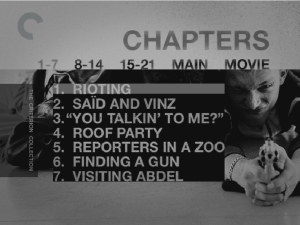

One could look from a broader perspective and see that La Haine reflects an older tradition of shooting social realist dramas such as A Taste in Honey in black and white.

This is only one possible reason for the choice. There’s nothing funny or glamorous about death. It’s real, it’s happening, and people are dying. One of the more immediate effects of the monochromatic choice of colors is the more serious tone of the film. Unlike most recent films in the same genre, La Haine is shot in black and white. The color of the streets is black and white The violence in La Haine doesn’t need special effects to prove a point. Sometimes the power of understatement is what it takes to point out something so egregious that it would be far better if it weren’t true. It seeps through the boys’ identities and lives. There are no shootouts or last stands.

The rejection by the people around them isolate them. There is no escape from the violence in the streets, in the mind, and in the eyes of others. The suspicion of others causes them to be doubly careful. However, what is most striking about this film is the psychological violence done to the boys. The only stunt is the struggle to survive. Each of these scenes is brutal, but lack the Michael Bay flair of loud explosions and death defying stunts. Then, there is the retaliation by Hubert, revolver in hand. There’s the dark moment where the policeman kills Vinz. There’s the fight with the skinheads in the street, where Hubert and Said are beaten by maniacs. There’s the less than gentle hassles with the police as well as the torture in the police offices. La Haine has its moments of physical violence. Sometimes, shootouts should be left to the Wild West Vinz, Hubert, and Said lead the viewer through the ups and downs of what seem to be a relatively normal day in the projects.

Yet, it’s three ordinary boys living the slums near Paris who take the stage in the film. This could be an investigative journalist’s moment to expose the lies about the despair of the mostly displaced refugee communities outside of the city, Spotlight style, with all the glam and glitz of All the President’s Men. This could be a procedural about the French police force’s endless crusade against crime in the suburbs around Paris. One of the more striking aspects of the “hood” or banlieue film, La Haine (literally, “the hate” ), is the choice of protagonists. Innocence and Violence in the Slums of La Haine


 0 kommentar(er)
0 kommentar(er)
